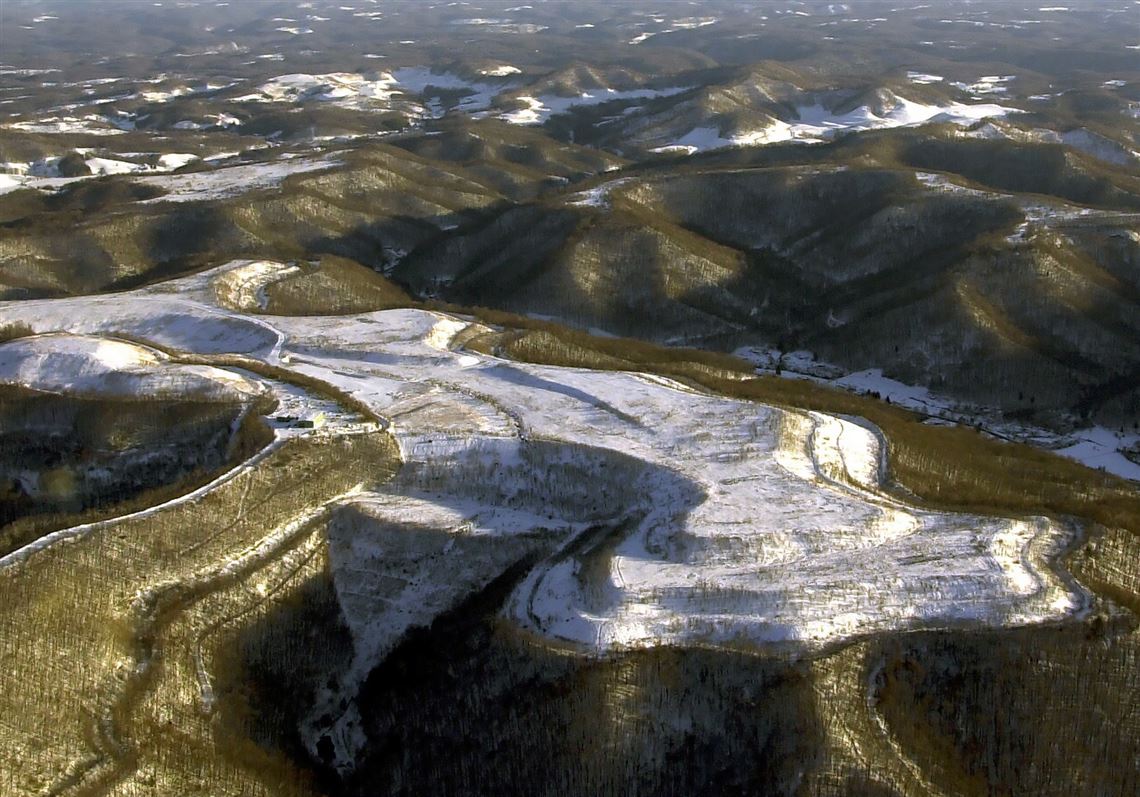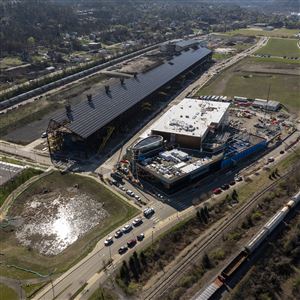In the coalfields of Appalachia, and in policy circles in Washington, D.C., a popular phrase in recent years used by mine workers, coal lobbyists and President Donald Trump is the “war on coal.” What they’re describing is the supposed effect of environmental, health and safety regulations on the coal economy and jobs. Truth be told, however, and verified by most economists, is that electric utilities are burning more and more natural gas rather than coal, and that accounts for the lion’s share of coal’s demise, not regulation.
But there is a war going on — a war on coal communities — and it’s called strip mining.
This war — waged by the fossil fuels and electric utility industries — has been ripping through rural America for the last 80 years or so, and its effects have been devastating. The damage started in earnest during the 1940s with ever-enlarging mining technologies: mechanized shovels, dozers, draglines, haulage trucks and mountain-side augurs. Contour stripping gouged thousands of miles through Appalachian mountains, leaving highwalls and visible scars that remain today. Spoil and overburden were pushed “over the side,” silting up and/or polluting streams — some 5,000 miles worth by one count.
With forests cleared and hillsides scraped bare, down-mountain flooding and landslides were made worse, as anyone in Appalachia who has lived near a strip mine will tell you. Strip mine blasting knocked homes off foundations; local roads were torn up or taken out of service. In some areas, the “broad form deed,” a nefarious property document, gave mineral owners the right to run roughshod over surface owners to get to the coal. Uppity landowners and activists were met with beatings, arson or jail time.
Coalfield citizens have said for decades that one of the major and unheralded impacts of strip mining, especially in small rural communities, is the effect it has on driving people out of those communities. In some cases, the mining companies make no bones about it, directly buying up homes in the path of their mining operations. Arch Coal Co., through a subsidiary, bought up more than half of the 231 houses in Blair, W.Va., in the 1990s. In other cases, the “driving out” is more indirect, and takes place over time, as in the daily harassment of mining activities, coal dust, truck traffic, blasting, the diminution of the local tax base and families leaving one by one.
“It’s unreal,” said Lora Webb of Lindytown, W.Va., in the fall of 2008, speaking with a newspaper reporter. “It’s like we’re living in a war zone.” Ms. Webb and her husband were then leaving their community; they had borne the assault from a nearby Massey Energy strip mine — a 20-story dragline, daily blasting, the dust clouds and fly rock that rained down on their home and garden. They watched the nearby creeks and hollows disappear and their community slowly die. That story is repeated across the decades in Appalachia as the real war on coal communities has been waged.
Out West, meanwhile, the assault has come in broad strokes with the look of a military-styled mobilization. In the late 1960s and early 1970s, something called “the East-West shift” began taking form. The big money headed west for coal — away from the Eastern deep-mines with high BTU-value coal dug by United Mine Workers, to “cheaper-to-extract,” non-union, low-BTU, strippable coal in places like Montana and Wyoming. In 1971, the “North Central Power Study,” written jointly by the U.S. Bureau of Reclamation and 35 major utilities — came like a bolt of lightning to Northern Great Plains ranchers. It proposed 42 coal-burning power plants for the region, 21 of them in Montana fueled by big strip mines. It also projected using 2.6 million acre-feet of water annually from Western rivers such as the Yellowstone for power plant cooling and coal cleaning. The impacts of such a plan — with assorted rail spurs, pipelines and power lines — would be massive. While this plan per se did not fully materialize, portions of it would unfold piecemeal in the decades ahead.
Coalfield communities fought back. In the 1940s, farmers in Indiana and Ohio — seeing what stripping did to agricultural land — were among the first to call on states to ban strip mining. Regulation came instead — weak regulation. Most state strip mining laws did not work. By the time of Earth Day 1970, when national environmental concerns began to rise, a new political base formed. Appalachian activists, Midwest farmers, Northern Plains ranchers and Native Americans joined with environmental organizations to focus on Congress for help. By 1971, over a dozen strip-mine bills were introduced, including one by Rep. Ken Hechler, D-W.Va., to ban all surface coal mining in six months.
But in Congress, there would be no quarter for banning or phasing out strip mining, as the oil/coal/utility axis was just too powerful. Even prohibiting strip mining on steep slopes could not get traction. As a series of regulatory bills were considered during the mid-1970s, a fierce legislative battle ensued, with dozens of hearings, intense lobbying and more than 500 offered amendments. All kinds of industry and legislative maneuvering occurred to stop the bills, including a protest parade of 500 coal trucks to Capitol Hill from Appalachia.
President Gerald Ford vetoed two bills approved by Congress in 1974 and 1975. But in 1976, Jimmy Carter promised he would sign a strip-mine bill during his presidential campaign, and Congress sent him the Surface Mining Reclamation and Control Act of 1977, which he signed in the Rose Garden with invited coalfield activists looking on. But then, for the next 40 years, each subsequent administration — from Reagan through Obama, and now Trump — took aim at the law, most in a bad way, weakening it, subverting it, cutting budgets, closing offices, diverting funds or issuing “lay back” and “do-not-enforce” directives. Thus enabled, the “war on coal communities” and the ruinous damage to streams, forests, wildlife habitat has continued for 40 years.
In Appalachia, meanwhile, the strip mining war in recent years has been technologically empowered with a savage technique called “mountain top removal” — that is, decapitation of mountain tops to get at their underlying coal. To date, a Delaware-size string of mountain tops have been removed — at least 500 by one count — with their blasted-off “tops” pushed into huge “valley fills,” burying headwater streams and creating unstable masses of exposed rock waste. Out West, the East-West shift, now more fully formed, finds strip-mined coal from Wyoming and Montana shipped by 100-car unit trains to various utilities or points west for export to Asia. As for Western reclamation, less than 10 percent of mined land in Montana, for example, has been fully restored. Ranching and farming communities, meanwhile, have seen their fragile and economically vital underground aquifers damaged or depleted, and their local cultures transformed.
This February, Congress overturned, and Mr. Trump signed, a revocation of the Obama administration’s Stream Protection Rule — aimed at protecting streams from the impacts of mining. In addition, SMCRA’s Abandoned Mine Lands Reclamation Fund — financed in part by a fee on extracted coal and aimed at restoring millions of acres of abandoned mines and damaged waters — has fallen way short of its goals, slammed by a 2017 inspector general’s report for diverted monies. Some 3.5 million Americans live less than a mile from an abandoned, and likely polluting, coal mine site.
In Washington last month, the Interior Department “observed” (not celebrated) the 40th year of the Surface Mining Reclamation and Control Act of 1977 — which many coalfield citizens now regard as a broken promise; they thought meaningful protections were coming to their communities. While some conscientious field inspectors and regulators have tried to make that law work, the 40-year record is more a textbook case of how a well-intentioned law can be undermined by budget-cutters and opposition politics.
Mr. Trump, meanwhile, is now aiding and abetting the continuing assault on coal communities, proposing, for example: to cut $111 million from the Office of Surface Mining budget; open up public lands to coal leasing and strip mining; eliminate the $89 million Abandoned Mine Land Economic Development Pilot program; eliminate the Appalachian Regional Commission (95 percent of its 420 counties voted for Trump); shut down a National Academy of Sciences study investigating cancer rates near mountain-top removal sites; severely cut the economic revitalization POWER grants for coal communities; and give government subsidies to failing coal companies.
Rather — to help those folks in rural America he claims as his constituency — Mr. Trump should end the “war on coal” rhetoric, reverse his evisceration of environmental laws and community assistance programs, and empower his agencies to uphold the promises repeatedly made to coalfield citizens over the last 40 years.
Jack Doyle lives in Penn Hills. He worked on the 1977 strip mine law for the Environmental Policy Center and attended the signing of that law at the White House. Today he works as a consultant and publishes The Pop History Dig website (pophistorydig.com).
First Published: September 10, 2017, 4:00 a.m.
















